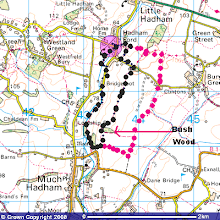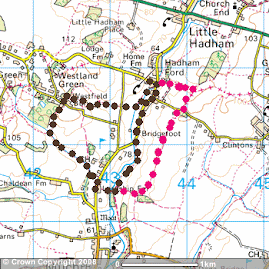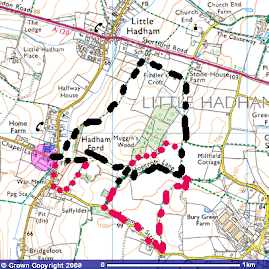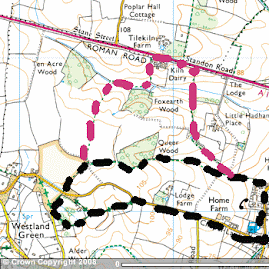Saturday 19th Dec.
Had a whole weekend in West and North Norfolk,heading up towards Kings Lynn mid morning. First stop: KL docks where I spent sometime searching for the iceland gull. I was after photos, but soon obvious it was not going to be close. Eventually found it adjacent to Shed 25 on the right as you drive into the docks, opposite the fishing fleet. From here, off to Snettisham RSPB Reserve.
Here, a female goldeneye was on the water as I wandered along the muddy footpath. From the beach, there were huge numbers of waders. As I approached 20,000 golden plovers took to the air and out on the mud flats, 1000's oystercatchers, godwits, knot, dunlin, lapwings, redshank etc etc. Unfortunately, very windy so scoping the mud was not easy and virtually impossible to focus in on any specific bird. After half an hour I headed back to the car, happy with the views I had got, but no photos. A large flock of long tailed tits accompanied me back to the car park and a cetti's warbler called. Geese, mainly greylag and canadas were in local fields, so my weekend list was off to a good start.
 |
| female goldeneye (Snettisham) |
 |
| long tailed tit (Snettisham) |
From here, next stop was the beach car park and clifftop at Hunstanton. Out to sea were the regular suspectes, few waders, including 1st curlew of the day, with oystercatchers, black headed gulls and common gulls in the car park and on the golf course. Far out to sea, a bird moving without wingbeats and cutting the water. A fulmar, not a regular sight so close inland in winter and a good December record for me. It spent time moving closer to the cliffs but was always below the clifftop, so only photo is this one, about half a mile off the coast.
 |
| Very distant fulmar (Hunstanton) |
 |
| Oystercatcher (Hunstanton) |
Before long, I was off to the next destination, Holme beach. Once parked, having noted 1000's of pink foot geese in fields, I wandered to the beach through masses of sea buckthorn, fieldfares, redwings and a mistle thrush were feeding on the orange berries, but nothing more exotic. From the beach, a few red throated divers, but no sea duck. A slavonian grebe and several great crested grebes were not too far out, but constantly diving, so no distant blurred photos. Back over the golf course and on to Thornham. Twite flock were next to the car park, but although warm, the light was poor and so no good photos. A little egret lazed over Thornham Marsh and plenty of brent geese. A redshank in the pool near the car park was noted but I decided time was against me to wander all the way out for the shore larks. The light was disappearing quickly and there were still a few places I wished to visit.
I had to pop into the One Stop Nature Shop at Burnham Deepdale before a quick trip to Brancaster Staithe. The regular turnstones flitted around the crab pot, dinghies and the 3 other bird watchers who were observing the red necked grebe that had been present for a week. good binocular views, but a combination of poor light and distance meant nothing too good on the camera.
 |
| Twite (Thornham) |
 |
| Turnstone (Brancaster Staithe) |
 |
| Red necked grebe (Brancaster Staithe) |
 |
| same rng |
After this I shot up to Choseley drying barns where a distant rough legged buzzard was noted before I paid a very late visit to Titchwell. By now it was approaching 3pm and the light meant no photos. Marsh harriers were coming into roost and in amongst the numerous teal and shoveler, a couple of pintail along with avocets, godwits and flyby dunlins.
A coffee and I was off to my room for the night at Langham. A place I have stayed at before, only this time I was given the barn and very smart it was, too. Kitchen, lounge, bedroom and bathroom, all for £29.00 for the night. I reckon I shall be using this place again..
Once washed etc, I set off to pick up Gary for a few jars in Walsingham and plan the following NEWS day. From here, I then enjoyed fish and chips on Wells quayside before finishing by a quick check on Kelling Heath for moths: far too windy, so completed the day with a quick pint in The Chequers at Binham before setting the alarm and having a relatively early night.
Sunday 20th Dec
Awoke early, so set off for a quick first light check on Lady Anne's Drive for any owls, but just got 1 little owl on a telegraph post near Binham. From Holkham popped over to the beach car park and Wells to note anything on the sands near the lifeboat station, but not a lot as a sand digger was already working at 7.45a.m. Smart new car park here, though.
Then, it was off to Egmere to collect Gary before we set off for Overstrand and a beach walk to Cromer Pier for my BTO Non estuarine wader count. We started at 9.00 and noted every bird on land, beach and sea. Not too much seen and nothing particularly noteworthy. Couple of passing brents and 3 red throated divers were as good as it got.
By the time we arrived at Cromer pier we had noted 23 species of bird and a grey seal. High counts of herring and black headed gull, but not a single wader.
A coffee, sausage sandwich and taxi back to collect the car at Overstrand and then we set off back eastwards again. Not before a quick sea watch with the scope and, remarkably, just in time to witness 200+ (and probably 300+) great crested grebes flying west. Also, 2 guillemots and another red throated diver and distant fulmar. As I had yesterday at Burnham Deepdale, had to pop into Cley Visitors' Centre to drop of some copies of my Guide to North Norfolk Birding Sites, before we headed for Brancaster Staithe so Gary could get the red necked grebe, a lifer. It didn't appear to be present whilst we searched for half an hour, but a flyby and then 2 red breasted merganser drakes were good along with turnnstone, dunlin, redshank, teal, curlew, wigeon etc. From here, back to Choseley where a rough legged buzzard was seen from Chalk Pit Lane and then into Titchwell. We got as far as the island hide as the light faded once again. Nothing apart from a brambling and redpolls in trees near the VC, associating with green, chaff and goldfinches.
We decided that, as the tide had receded, chance for the rng and so it proved. The bird was the far side of the channel, constantly diving and, mysteriously, disappearing for 5 minutes before re appearing in the place it had been earlier. Scope views for Gary before we popped into Lady Anne's Drive, but no white fronted geese or owls, so off to drop off Gary and head home.
An excellent 2 days.
 |
| Overstrand to Cromer: non estuarine (non) wader survey! |
 |
| Shoveler (Titchwell) |
 |
| Teal in different stages of emerging from eclipse plumage (Titchwell) |
 |
| Invasive species (Overstrand cliffs) |
Species List: ones in bold are NEWS records:
red throated diver, little grebe, slavonian grebe, red necked grebe,
great crested grebe, fulmar,
cormorant, little egret, grey heron, mute swan (10 sp) pink footed goose, canada goose, greylag goose,
brent goose, shelduck, mallard, gadwall, pintail, shoveler, wigeon,(20 sp) teal, tufted duck, goldeneye, red breasted merganser, red kite, marsh harrier, rough legged buzzard, common buzzard, sparrowhawk, kestrel (30 sp) red legged partridge, grey partridge,
pheasant, water rail, moorhen, coot, oystercatcher, avocet, grey plover, golden plover (40 sp) lapwing, turnstone, dunlin, redshank, greenshank, black tailed godwit, bar tailed godwit, curlew,
black headed gull, common gull, (50 sp)
herring gull, lesser black backed gull, great black backed gull, iceland gull,
guillemot, stock dove,
wood pigeon, collared dove, tawny owl, barn owl, (60 sp) little owl, meadow pipit, pied wagtail ,
wren, dunnock, robin, song thrush, redwing, mistle thrush, fieldfare, (70 sp)
blackbird, cetti's warbler, great tit, coal tit, blue tit, long tailed tit,
magpie, jay, jackdaw, rook, (80 sp)
carrion crow, starling, house sparrow,
chaffinch, brambling,
linnet, twite, redpoll,
goldfinch, greenfinch, (90 sp) bullfinch, reed bunting, yellowhammer, corn bunting: 94 in total.































































































